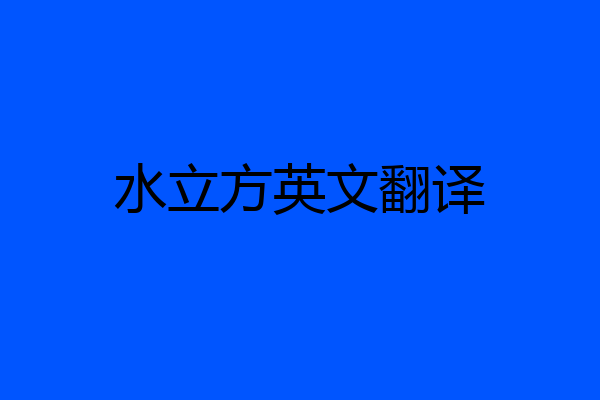
幼幼熙熙
鸟巢和水立方英语翻译:Bird's Nest and Water Cube。
国家体育场(鸟巢)位于北京奥林匹克公园中心区南部,为2008年北京奥运会的主体育场。工程总占地面积21公顷,场内观众坐席约为91000个。举行了奥运会、残奥会开闭幕式、田径比赛及足球比赛决赛。
奥运会后成为北京市民参与体育活动及享受体育娱乐的大型专业场所,并成为地标性的体育建筑和奥运遗产。
体育场由雅克·赫尔佐格、德梅隆、艾未未以及李兴刚等设计,由北京城建集团负责施工。体育场的形态如同孕育生命的“巢”和摇篮,寄托着人类对未来的希望。设计者们对这个场馆没有做任何多余的处理,把结构暴露在外,因而自然形成了建筑的外观。
2003年12月24日开工建设,2008年3月完工,总造价22.67亿元 。作为国家标志性建筑,2008年奥运会主体育场,国家体育场结构特点十分显著。体育场为特级体育建筑,大型体育场馆。主体结构设计使用年限100年,耐火等级为一级,抗震设防烈度8度,地下工程防水等级1级。
2014年4月中国当代十大建筑评审委员会从中国1000多座地标建筑中,综合年代、规模、艺术性和影响力四项指标,初评出二十个建筑。最终由此产生十大当代建筑。
北京鸟巢——国家体育场为初评入围建筑之一 [2-3] 。作为北京2022年冬奥会冰上项目场馆,国家体育场改造工程将于2020年初开工。


花花要减肥
鸟巢水立方翻译成英语:Bird's Nest Water Cube。
作用功能
鸟巢作为北京2008年奥运会与残奥会的主会场,国家体育场(即“鸟巢”)将承办北京奥运会、残奥会开闭幕式、田径及足球等相关活动和赛事。
盘根错节的体育场立面与几何体的建筑基座合而为一,如同“树和树根”组成了一个体量庞大的建筑编织体。国家体育场整体设计新颖激进,外观如同孕育生命的巢,更像一个摇篮,寄托了人类对未来的希望,因而成为2008年北京奥运会的标志性建筑,博得了世界的瞩目。
国家体育场用于举办主要的国际、区域和中国的国内大赛事,另外也包括一些非传统体育赛事,为体育迷们提供一个感受新鲜体育文化的机会;除了体育赛事,其他一些大型活动,如:文艺演出、非商业性质的政府主办的大型活动以及私营企业的大型活动也将在国家体育场举行。
国家体育场将创造其自己的文化和人文氛围,通过吸引最好的中国国内和国际体育活动和表演艺术机构、优秀的服务和先进的管理技术,使国家体育场成为全国范围内最优秀的大型体育活动和表演场所,国家体育场将成为全世界其他国家看中国的一个新窗口。

abc123459876
鸟巢:Bird's Nest 水立方:Water Cube 这是形象的说法。按体育馆翻译分别是国家体育场:National Stadium 国家游泳中心:National Aquatics Center

奈奈小妖精
“水立方”(Water Cube)国家体育馆:National Gymnasium鸟巢:Beijing National Stadium (Bird'sNest/Olympic Stadium) 水立方:National Swimming Center (The water Cube)

馨怡FANG
1.北京奥运国家体育场就是俗称的"鸟巢"
"鸟巢"的英文名称是Nest-type Beijing Olympic Stadium或者Beijing National Stadium (Bird's Nest/Olympic Stadium)
鸟巢英文单词是bird nest
2."水立方"的英文是water cube Beijing National Aquatics Cente或water cube
“鸟巢”和“水立方”的英文简介
Beijing National Stadium
The Beijing National Stadium (traditional Chinese: 北京国家体育场; simplified Chinese: 北京国家体育场; Hanyu Pinyin: Běijīng Guojiā Tǐyuchǎng; Tongyong Pinyin: Běijīng Guojiā Tǐyuchǎng), also known as the National Stadium,[1] or the "Bird's Nest" (鸟巢) for its architecture, is a stadium under construction on the Olympic Green in Beijing, China that is scheduled for completion in March, 2008[2]. The stadium will host the main track and field competitions for the 2008 Summer Olympics, as well as the opening and closing ceremonies. It is located right next to the Beijing National Aquatics Centre.
Design
In 2002, Government officials engaged architects worldwide in a design competition. Pritzker Prize-winning architects Herzog & de Meuron collaborated with ArupSport and China Architecture Design & Research Group to win the competition. Contemporary Chinese artist, Ai Weiwei, is the Artistic Consultant for design.[3] The ground was broken on Christmas EveDecember2003, and construction started in March2004, but was halted by the high construction cost in August2004 and continued again. In January 2008, concerns about construction working conditions arose when it was revealed that at least 10 workers had died during the stadium's construction.[4] Controversy also surrounded the alleged forced evictions of many residents so the construction could go ahead.
Capacity
The stadium can seat as many as 91,000 spectators during the Olympics. The capacity will then be reduced to 80,000 after the Games. It has replaced the original intended venue of the Guangdong Olympic Stadium[citation needed]. The stadium is 330 metres long by 220 metres wide, and is 69.2 metres tall. The stadium uses 258,000 square metres of space and has a usable area of 204,000 square metres. It was built with 36 km of unwrapped steel, with a combined weight of 45,000 tonnes. The stadium has some 11,000 square metres of underground rooms with waterproof walls. The stadium will cost up to 3.5 billionyuan (≈423 million USD).
Upon completion, this stadium will boast a state of the art Solar PV system produced by Suntech Power[
Beijing National Aquatics Centre
The Beijing National Aquatics Centre, also known as the Water Cube (or abbreviated [H2O]3 [1]), is an aquatics centre that was built alongside Beijing National Stadium in the Olympic Green for the 2008 Summer Olympics. Ground was broken on December 24, 2003.
Design
In 2002, Government officials engaged architects worldwide in a design competition. Pritzker Prize-winning architects Herzog & de Meuron collaborated with ArupSport and China Architecture Design & Research Group to win the competition. Contemporary Chinese artist, Ai Weiwei, is the Artistic Consultant for design.[3] The ground was broken on Christmas EveDecember2003, and construction started in March2004, but was halted by the high construction cost in August2004 and continued again. In January 2008, concerns about construction working conditions arose when it was revealed that at least 10 workers had died during the stadium's construction.[4] Controversy also surrounded the alleged forced evictions of many residents so the construction could go ahead.
Capacity
The stadium can seat as many as 91,000 spectators during the Olympics. The capacity will then be reduced to 80,000 after the Games. It has replaced the original intended venue of the Guangdong Olympic Stadium[citation needed]. The stadium is 330 metres long by 220 metres wide, and is 69.2 metres tall. The stadium uses 258,000 square metres of space and has a usable area of 204,000 square metres. It was built with 36 km of unwrapped steel, with a combined weight of 45,000 tonnes. The stadium has some 11,000 square metres of underground rooms with waterproof walls. The stadium will cost up to 3.5 billionyuan (≈423 million USD).
Upon completion, this stadium will boast a state of the art Solar PV system produced by
Suntech Power[

小小锅盖子
国家体育场(鸟巢) Beijing National Stadium (Bird's Nest/Olympic Stadium)国家游泳中心(水立方 ) National Aquatics Centre(Water Cube)
优质英语培训问答知识库